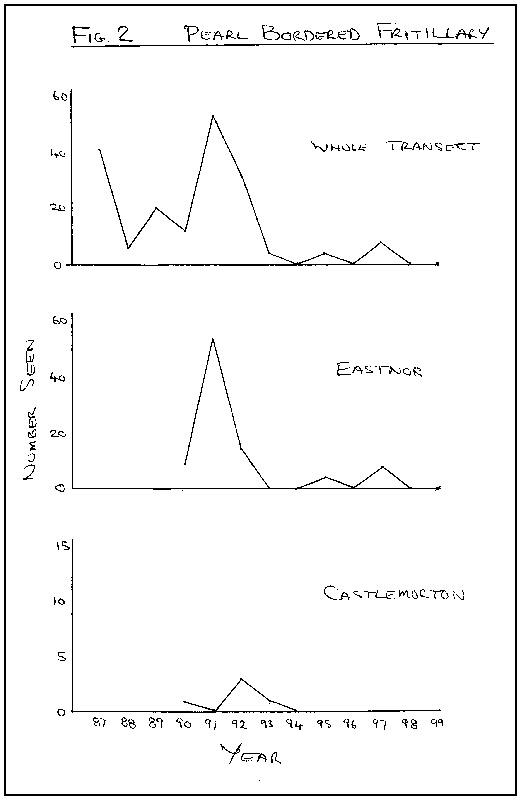

The Malvern Hills have historically been an attractive habitat for many species, the lower slopes and commons grazed by cattle and sheep produced a mosaic of grass, herbs and bracken that provided suitable conditions for a wide range of plants and invertebrates to flourish. Notable among the invertebrates were no less than five Fritillary species, the High Brown, the Dark Green, the Pearl Bordered, the Small Pearl Bordered and, if woodland edges were included, the Silver Washed.
In the mid 80’s it became clear that the High Brown was fast becoming very rare nationally and in ‘86 Butterfly Conservation obtained funding from English Nature for a survey of High Brown breeding sites on the Malvern Hills. This was carried out by Matthew Oates (now Conservation Adviser to the National Trust.) and it showed the existence of a number of strong breeding colonies spread over the southern hills, confirming that the Malverns were one of the few national strongholds of this now rare species. In view of its national importance BC set up a Transect Walk in ‘87 covering the main breeding areas on Castlemorton Common and Eastnor Park so that a check could be kept on the butterfly’s status.
These transect walks are now well known, but briefly within prescribed limits of temperature, sunshine duration and wind force, the observer walks a set route counting all species of butterflies entering an imaginary box extending 5m in front and 5m each side. The Malvern Hills walk is some 3.3km, thus the area swept by the observer is about 3.3ha, and since the total breeding area is of the order of 30ha it is evident that only some 11% of the total area is sampled although the best breeding sites are included. Further, since the transect takes on average about 70 mins to walk, each 5m by 10m area is in view for about six seconds. The method is therefore a sampling process and it is statistically valid to compare the aggregate number of sightings of any species during a year (known as the Annual Index) with that obtained in other years. It is also important to understand that a zero Annual Index does not mean that there are no butterflies of that species on the site.
By ‘93 the Annual Index had declined to about 10% of the ‘87 figure so BC negotiated a Species Recovery Programme contract with EN to study site ecology and to recommend a site management programme. Next year BC volunteers commenced annual bracken management in Eastnor Park and BC’s Conservation Officer agreed a bracken management plan for Castlemorton SSSI with EN and supervised its implementation by Malvern Hills Conservators. Test plots were set up on both sites to monitor the effects of the management on plant growth and distribution. Both programmes continued until 1999. The transect walk also continued and the Annual Indices are shown in Fig.1, the top figures are those for the whole Malvern Hills Transect walk, the Eastnor figures are for the best breeding site in the park and the Castlemorton figures are for the breeding sites on east Swinyard and Castlemorton Common. Figures for Chase End Hill (supplied by Ledbury Natural History Society) are included for comparison purposes although collected on a rather less rigorous basis. It can be seen that all four graphs have similar characteristics although different management regimes were employed on the Eastnor, Castlemorton and Chase End sites. The major cause of fluctuation in the Index is almost certainly the weather, particularly cold damp weather during the emergence period in June and this is the subject of a separate investigation. Other factors such as bird predation and parasitism can also cause local variations. The overall picture is one of decline, the ‘95 peak being only 50% of the ‘87 peak and the current trough being the lowest ever.

Figs. 2 and 3 show similar data for the Pearl Bordered and the Small Pearl Bordered but it is interesting to note the peaks occur in different years from the High Brown and that they also differ between the Eastnor and Castlemorton sites. However the overall picture is also one of decline.

figure 2

figure 3
By ‘98 the seriousness of the situation was clear, the management programmes which appeared to be beneficial in ‘94 and ‘95, were not working. BC obtained a further contract with EN to repeat the survey of ‘87 and engaged Simon Barker of WWT to carry it out. The report makes depressing reading with a catalogue of sites overrun by scrub and ever increasing bracken density. EN grasped the nettle, spurred on by the High Brown’s nationally scarce status, its position in the Regional Action Plan, and an unexpected chunk of Government money, and sprang into action. A partnership was formed between MHC, EN, local landowners, NT, BTCV and the MHAONB Office to draw up a plan to restore the Malvern Hills. The plans include the restoration of archaeological sites and a number of the historic well-heads situated on the Hills, but the major part of the expenditure will be for scrub removal and bracken management and the construction of cattle grids to the south of British Camp to allow the re-introduction of grazing by animals. Grazing is expected to re-create the ecological conditions required by the High Brown and other Fritillaries. The total cost of the project is estimated to be £600,000 largely provided by the Heritage Lottery Fund, and the major part of this expenditure has been justified by the need to save the High Brown Fritillary. Thus 13 years of patient but enjoyable work may at last be paying off.
| WBRC Home | Worcs Record Listing by Issue | Worcs Record Listing by Subject |